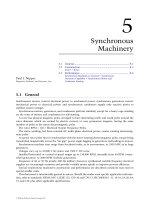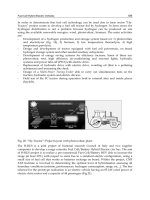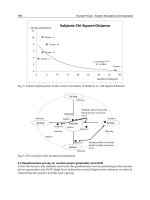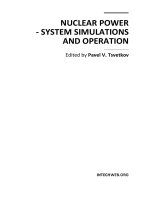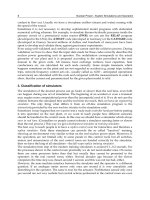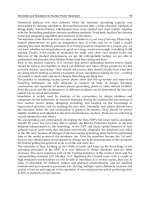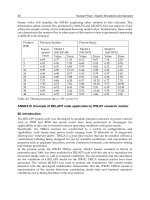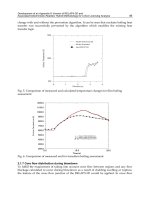Nuclear Power System Simulations and Operation Part 7 potx
Bạn đang xem bản rút gọn của tài liệu. Xem và tải ngay bản đầy đủ của tài liệu tại đây (355.2 KB, 15 trang )
Analysis of Error Propagation Between Software Processes
79
with return value equal to -1, which indicates an error, and the external variable errno is set
appropriately. Many of these are described in the manual pages and can be identified as the
failure effect on the local process. However, not all failure modes are represented as error
cases in the manual pages. We make use of test programs to identify these.
Reference Variable Failure mode
F.29.3.A Parameter shmflg Not specified at all
F.29.3.B Parameter shmflg
Is not one of IPC_CREAT, IPC_EXCL, SHM_HUGETLB
or SHM_NORESERVE
F.29.3.C Parameter shmflg Is of wrong type
F.29.3.D Parameter shmflg No permission mode is set
F.29.3.E Parameter shmflg
Access permission is given to all users, instead of user
only
F.29.3.F Parameter shmflg Permission mode is write when it should have been read
F.29.3.G Parameter shmflg Permission mode is read when it should have been write
F.29.3.H Parameter shmflg Permission mode is set without user access
F.29.3.I Parameter shmflg IPC_EXCL specified without IPC_CREAT
F.29.3.J Parameter shmflg
Wrong flag specified i.e. IPC_CREAT | IPC_EXCL when
not intended
Table 2. Failure modes for parameter shmflg for the shmget() system call
A test program is written to execute a failure mode while the failure effect is monitored.
Such test programs have the possibility to execute an injected failure mode.
Based on such test programs one can determine the effect of failure modes. E.g. the effect for
failure mode F.29.3.D ”no permission mode is set” was determined to be: no processes can
access the shared memory segment unless they are privileged. Checking the value of the
parameter shmflg to identify whether the permission mode is set is easily done performing
static analysis, thus this failure mode can be detected in source code.
Table 3 shows the complete FMEA for the failure modes related to the shmflg parameter of
shmget() from Table 2.
Similarly, the remaining system and library calls are analysed. The failure modes identified
in the analysis of these calls are related to passing of arguments and handling return values,
and can be grouped as follows:
• Argument refers to uninitialized variable/pointer.
• Argument is of different type than specified in function definition.
• Argument refers to null-pointer.
• Argument is freed.
• Argument refers outside an arrays size.
• Argument is an array of chars which is not null-terminated when required.
• Return value is not retrieved from a non-void function.
• Return value is not checked to determine successful call.
• Return value is not used in scope.
These failure modes are then compared with the checks that existing tools perform to
determine whether any of these are present in their checks.
Nuclear Power - System Simulations and Operation
80
Ref. Failure mode Local effect System effect Conclusion
F.29.3.A Not specified at all - - Does not compile
F.29.3.B Is not one of
IPC_CREAT,
IPC_EXCL,
SHM_HUGETLB or
SHM_NORESERVE
Unknown fla
g
and
permission is set
Segment ma
y
not
be created or
accessed
Detectability in
source code must
be determined
F.29.3.C Is of wrong type Uses the int value
of the type if
possible, unknown
flag and
permissions are
set on segment
Se
g
ment ma
y
not
be created or
accessed
Detectable in
source code
F.29.3.D No permission mode is
set
The process
cannot access the
shared memory
segment unless it
is run in
privileged mode
Other processes
cannot access the
shared memory
segment unless
they are run in
privileged mode
Detectable in
source code
F.29.3.E Access permission is
given to all users,
instead of user only
- Other users can
access the shared
segment
Detectability in
source code must
be determined
F.29.3.F Permission mode is
write when it should
have been read
Can write to
segment when not
intended
Other processes
can write to
segment when
not intended
Detectability in
source code must
be determined
F.29.3.G Permission mode is
read when it should
have been write
Cannot write to
segment
Other processes
cannot write to
segment
Detectability in
source code must
be determined
F.29.3.H Permission mode is set
without user access
The process
cannot access the
shared segment
unless it is run in
privileged mode
- Detectable in
source code
F.29.3.I IPC_EXCL specified
without IPC_CREAT
Exits with error if
segment already
exists
- Detectable in
source code
F.29.3.J Wrong flag specified
i.e. IPC_CREAT |
IPC_EXCL when not
intended
Tries to create
instead of getting
identifier for the
shared segment
- Detectability in
source code must
be determined
Table 3. Example of FMEA for the parameter shmflg of the shmget() system call
Analysis of Error Propagation Between Software Processes
81
4.2 Analysis tools
There are several existing analysis tools which identify different types of errors. These tools
include both static and dynamic analysis methods. In (Sarshar, 2007), over 20 tools were
examined and compared to determine what kind of errors they detect. Of these tools, one
group performs checks on passing of arguments, another group warns if a return value is
not retrieved and a third group warns about sequential issues. The tool Splint (Secure
Programming Lint, 2008) was the only tool which gave warnings on all three groups.
Therefore, Splint was chosen for assessment of our source code in part three. None of the
tools performed checks on argument values and they did not check all argument types to be
correct.
Based on the available documentation on existing analysis tools, we assume that some
tools can check arguments and some tools can check the return value for the following
issues:
• Types – assignment of variables, passing arguments of different type than function
expects.
• Null pointers – a common cause of failures is when a null pointer is dereferenced.
• Definitions – all function parameters and global variables used by a function must be
defined before a call, and the return value must be defined after the call.
• Allocations – concerns: reallocating storage when there are other live references to the
same storage, or failing to reallocate storage before the last reference to it is lost.
• Aliasing – program errors often result when there us unexpected aliasing between
parameters, return value, and global variables.
An important difference between the identified failure modes from the FMEA and the
checks existing tools perform is to check a variable value in the context of the relevant
function it is passed to. E.g. the system call shmget() has an argument of type size_t; As a
data type, the variable must be checked to be of correct type and its value must be checked
to be within the variable limits. Most existing analysis tools do these checks. But, in the
context of the function the argument is passed to, the variable must be checked to determine
e.g. whether its value is smaller than the maximum size of a shared memory segment (set by
the operating system).
The next step was to assess the source code for the identified failure modes that existing
tools do not check for. To automate this process, we made use of a prototype tool described
in (Sarshar & Winther, 2008). The tool was modified for this study and its purpose was to
identify different attributes for each argument that was passed to a given function. If
statically detectable, the following attributes were determined; the argument type, value,
name, whether it was an array and if so, its size. This information was used as input to
check the arguments for the potential failure modes. Several of these checks were
automated; however, a majority was done manually by examination of the argument
attributes against the FMEA sheets for each function.
Splint was also applied on the source code of our case study with the checks described in the
list above. However, the tool can also do more powerful checks enabled by source code
annotations. Annotations are stylized comments that documents assumptions about
functions, variables, parameters and types and follow a predefined syntax. To use the more
powerful checks, the source code must be edited to add notations. This requires time and
effort and was not applied in this case study. The use of annotations for more powerful
checks applies to most static analysis tools.
Nuclear Power - System Simulations and Operation
82
5. Results
A subset of 19 external calls has been analysed using FMEA to identify potential failure
modes that can cause a process to fail or propagate error. The examined functions were
called 309 places in the source code.
In 242 of the cases, the return value from an external call was not retrieved or checked. In
general, the return value often indicates whether a function succeeded or failed for some
reason. If such failure is not handled, unexpected runtime errors can occur in a software
system. As an example, consider an application which writes some data to a file regularly.
The file is opened for reading successfully and the write function is called without checking
its return value. If the file was inaccessible (e.g. lost connection to server) the write function
would return a value indicating an error. If the error is not handled explicitly, a runtime
error may occur. Such an error often causes the operating system to give an error message to
the user and then terminates the application that caused the error. All unsaved data will be
lost in such events. However, not all calls are this crucial; it is more vital that the return
value from an open or write function is handled than the return value of a print to screen
function. 76 of the ignored return cases were for a print function.
Several of the examined functions had potential failure modes regarding the content of
arguments they receive. In example, char arrays passed to a group of functions must be null-
terminated and for another group they must not contain a given character. Our assessment
of the code did not identify any of these failure modes in the module.
The source code was also assessed using the tool Splint which gave near 2000 warnings on
the source code of the module. Table 4 (Sarshar, 2009) presents warnings given by Splint
and number of instances. In general, the tool reports many false positive warnings (which
add noise to the results and make it harder to spot the real problems). Though the number
of cases for the warnings on incompatible types and dangerous comparison are equal, there
is no relation between them.
Warning on Cases
Incompatible types 444
Dangerous comparison 444
Variable declared but not used 50
Value used before definition 160
Variable initialized to null value 14
Dangerous assignments 237
Test expression issues 163
Storage not released before return 37
Return value ignored 212
Possible buffer overflow with sprintf() 23
Arrow access of non-pointer 54
Other warnings 162
Table 4. Group of warnings given by the tool Splint
Analysis of Error Propagation Between Software Processes
83
Assessment of many existing systems in the industry can only be performed on the available
source code, and often, the specification is not available. This is where static analysis is
useful, some tools only need the source code to perform their analysis. However, if
annotations are necessary to perform an assessment, expertise on the system is required.
The method proposed to use FMEA on system calls to identify potential failure modes and
then assess the source code for these potential failures. The intention was not to develop yet
another tool, therefore the identified failure modes were checked against the ones that
existing tools check. An interesting approach would be, if possible, to write these failure
modes as additional checks for existing tools. A disadvantage of the FMEA analysis is that it
only identifies a small fraction of the potential failure modes and it requires expert
knowledge on the system calls.
System and library calls are complex functions which interact with the kernel of the
operating system. The process of analysing such functions takes time and effort, but it only
needs to be performed once for each function. The result from this analysis indicates that it
is necessary to examine the source code of applications for failures related to system call
usage.
The source code of the input data processing module of the SCORPIO framework was
assessed using our approach and using the tool Splint. The user of analysis tools must be
critical to the results as all vulnerabilities are not guaranteed to be found, and identified
vulnerabilities are not all real problems. Splint gave a lot of warnings which were false
positives while the checks from the FMEA performed by us gave few false positives. The
reason for this is that we used a prototype tool to help us identify variable attributes, but the
checks were done manually. Performing manual checks is time consuming, but reduces the
chance of false positives since the analyser is required to have insight of the application.
Furthermore, it is difficult, if not impossible, to control and check the value of variables that
are passed to system services when performing static analysis.
Through the process of analysing the source code of the module, failure modes with the
potential to cause harm at runtime as an effect of fault triggering and error propagation
have been identified. These failure modes are related to usage of services provided by the
underlying operating system. Though the arguments sent to such functions are valid and in
accordance with the documentation, the majority of the potential failure modes detected in
the code were related to handling of return values from these functions.
We did not expect that this assessment would identify any serious failures in the code, and
the result demonstrates that this expectation is valid. Potential failures related to usage of
operating system services would have been identified using our method and none of the
potential failures identified is likely to cause the module to fail. However, taking these
results into account in new releases of the module will reduce its vulnerability.
6. Discussion
The methodology was applied on a subset of system calls, some of them related to shared
memory. This target was found to be suitable because it involved an intended channel for
communication between processes through a shared resource; the memory. We also
performed FMEA on other system calls to evaluate whether the method is applicable to a
wider class of functions and not restricted to those related to shared memory. The errors
identified in this approach are erroneous values in the variables passed to the system call
interface and errors caused when return, or modified, pointer variables are not handled
Nuclear Power - System Simulations and Operation
84
properly. From the analysis we know not only which functions behave non-robustly, but
also the specific input that results in errors and exceptions being thrown by the operating
system. This simplifies identification of the characteristics an error has in code, making it
easier to locate errors.
The method for analysing error propagation between processes primarily focuses on how
the process of interest can interact with and affect the environment (the operating system
and other processes). A complementary approach could be to analyse how a process can be
affected by its (execution) environment. In (Johansson et al., 2007), the authors inject faults
in the interface between drivers and the operating system, and then monitor the effect of
these faults in the application layer. This is an example where processes in the application
layer are affected by their execution environment. Comparing this method to our approach,
it is clear that both methods make use of fault injection to determine different types of
failure effects on user programs. However, the examination in (Johansson et al., 2007) only
concerns incorrect values passed from the driver interface to the operating system. Passing
of incorrect values from one component to another is a mechanism for error propagation
and relates to problems for intended communication channels. Fault injection is just one
method to evaluate process robustness in regards to incorrect values in arguments. In our
work, we examine the failure effects of several mechanisms: passing of arguments and
return values, usage of return values, system-wide limitations, and sequential issues. These
methods complement each other.
Understanding the failure and error propagation mechanisms in software-based systems
will provide the knowledge to develop defences and avoid such mechanisms in software. It
is therefore important to be aware of the limitations for the proposed approach. This
analysis only identifies failure modes related to the usage of system calls in source code.
Other mechanisms for error propagation that do not involve usage of the system call
interface will not be covered by this approach. This approach, however, complements
existing methods and static analysis tools. An infinite loop structure in code is one example
of a failure mode that does not make use of system calls. This failure mode can cause error
propagation because it uses a lot of CPU time/resources.
The FMEA method worked well on system calls and identified failure modes that could
cause error propagation between processes. However, the identified failure modes from the
FMEA do not apply directly to other operating systems. A new analysis must be performed
for a new programming language and operating system combination. Even though several
operating systems provide the same functionality, e.g. usage of shared memory, the
implementation of the service will be different. Thus, some of the failure modes may be
similar, yet their effects may not. And, in contrast to general FMEA approaches which
analyse functionality of software systems, our aim was to identify failure modes related to
the interaction of a program with operating system services.
7. Conclusion
The analysis and results from this case shows that the approach facilitates the detection of
potential failure modes related to the use of the system calls in operating systems. However,
this is without further analysis about their actual impact in the SCORPIO framework. Future
extension of the work can include examining the potential impact of these failure modes.
With so many potential failure modes it also seems that there needs to be some way to
prioritize or target the “important” failures that should be fixed based on the study. For
Analysis of Error Propagation Between Software Processes
85
example, the missing return values seem to become critical errors only under maintenance,
if the return values can change. Even though this is valuable to uncover, it would be more
valuable to quantify which potential failures would be critical if they occurred under the
current operational mode and which would not. This would help to indicate the usefulness
of the technique and provide some evidence that the failures occur with sufficient frequency
to justify the definition of a technique that targets them. Further extension of the work can
include exploring alternative techniques or quantify effort required to conduct this type of
analysis to make it easier to determine the trade-offs of using this technique in practice,
providing a quantitative analysis of the types of failure modes the analysis uncover and
providing usage guidelines to the practitioner.
8. References
Abdelmoez, W.; Nassar, D.; Shereshevsky, M.; Gradetsky, N.; Gunnalan, R.; Ammar, H. H.;
Yu, B. & Mili, A. (2004). Error Propagation in Software Architectures, metrics,
Proceedings of International Symposium on Software Metrics No10, pp. 384-393, Chicago
IL, ETATS-UNIS, USA, September 11, 2004.
Bacon, J. & Harris, T. (2003). Operating Systems – Concurrent and distributed Software Design,
1
st
ed., Great Britain: Pearson Education Limited, 2003.
Barmsnes, K. A.; Johnsen, T. & Sundling, C-V. (1997). Implementation of Graphical User
Interfaces in Nuclear Applications, Proceedings of Topical Meeting on I&C of VVER,
Prague, April 21-24, 1997.
Beck, H.; Bohme, H.; Dziadzka, M.; Kunitz, U.; Magnus, R.; Schroter, C. & Verworner, D.
(2002). Linux Kernel Programming, 3
rd
ed., Great Britain: Pearson Education Limited,
2002.
Bic, L. F. & Shaw, A. C. (2003). Operating Systems Principles, USA: Pearson Education, Inc., 2003
Bovet, D.P. & Cesati, M. (2003). Understanding the Linux Kernel, 2
nd
ed., USA: O’Reilly &
Associates, Inc., 2003.
Chou, A.; Yang, J.; Chelf, B.; Hallem, S. & Engler, D. R. (2001). An Empirical Study of
Operating Systems Errors, Proceedings of the 18
th
Symposium on Operating System
Principles (SOSP), Chateau Lake Louise, Banff, Canada, October, 2001.
Engler, D.R.; Chelf, B.; Chou, A. & Hallem, S. (2000). Checking System Rules Using System-
Specific, Programmer-Written compiler Extensions, Proceedings of Operating systems
Design and Implementation (OSDI), San Diego, California, USA, October, 2000.
Fredriksen, R. & Winther, R. (2007). Challenges Related to Error Propagation in Software
Systems, Proceedings of Risk, Reliability and Societal Safety (ESREL), pp. 83-90, ISBN
978-0-415-44783-6, Stavanger, Norway, June 25-27, 2007.
Goradia, T. (1993). Dynamic Impact Analysis: A Cost-Effective Technique to Enforce Error
Propagation, Proceedings of the International Symposium on software Testing and
Analysis, pp. 171-181, 1993.
Hatton, L. (1995). Safer C: Developing for High-Integrati and Safety-Critical Systems, Great
Britain: Mcraw-hill, 1995.
Hiller, M.; Jhumka, A. & Suri, N. (2001). An Approach to Analysing the Propagation of Data
Errors in Software. Dependable Systems and Networks (DSN), 2001.
IFE (Institute for Energy Technology) (2010). ProcSee, available from:
Jhumka, A.; Hiller, M. & Suri, N. (2001). Proceedings of 20
th
IEEE Symposium on Reliable and
Distributed Systems, pp. 152-161, New Orleans, LA, USA, October 23-31, 2001.
Nuclear Power - System Simulations and Operation
86
Johansson, A.; Suri, N. & Murphy, B. (2007). On the Impact of Injection Triggers for OS
Robustness Evaluation, Proceedings of the 18th International Symposium on software
Reliability Engineering (ISSRE), pp. 127-136, 2007.
Koenig, A. (1989). C Traps and Pitfalls, USA: Addison-Wesley, 1989.
Kropp, N. P.; Koopman, P. J. Jr. & Siewiorek, D. P. (1998). Automated Robustness Testing of
Off-the-Shelf Software Components, Proceedings of the Symposium on Fault-Tolerant
Computing, pp. 230-239, 1998.
Michael, C. & Jones, R. (1997). On the Uniformity of Error Propagation in Software,
Proceedings of the 12
th
Annual Conference on Computer Assurance (COMPASS), pp. 68-
76, 1997.
Mitchell, M.; Oldman, J. & Samuel, A. (2001). Advanced Linux Programming, 1
st
ed., USA:
New Riders Publishing, pp. 45-55, 2001.
Nassar, D.; Rabie, W.; Shereshevsky, M.; Gradetsky, N. & Ammar, H. (2004). Estimating
Error Propagation Probabilities in Software Architectures, Proceedings of
International Symposium on Software Metrics No10, pp. 384-393, Chicago IL, ETATS-
UNIS, USA, September 11, 2004.
Nutt, G. (2004). Operating Systems, 3
rd
ed., USA: Pearson Education, Inc., 2004.
Pinkert, J. R. & Wear, L. L. (1989). Operating Systems – Concepts, Policies, and Mechanisms,
USA: Prentice-Hall, Inc., 1989.
Sarshar, S.; Simensen, J.E.; Winther, R. & Fredriksen, R. (2007). Analysis of Error
Propagation Mechanisms between Software Processes, Proceedings of Risk, Reliability
and Societal Safety (ESREL), pp. 91-98, Taylor & Francis, ISBN 978-0-415-44783-6,
Stavanger, Norway, June 25-27, 2007.
Sarshar, S. (2007). Analysis of Error Propagation between Software Processes in Source
Code, Master thesis at Østfold University College, Norway, 2007.
Sarshar, S. & Winther, R. (2008). Automatic Source Code Analysis of Failure Modes Causing
Error Propagation, Proceedings of Risk, Reliability and Societal Safety (ESREL), pp. 183-
190, Taylor & Francis, ISBN 978-0-415-48514-2, Valencia, Spain, September 22-24, 2008.
Sarshar, S. (2009). Performing Code Interface Analysis on the SCORPIO Core Surveillance
Framework”, Proceedings of the 6th American Nuclear Society International Topical
Meeting on Nuclear Plant Instrumentation, Control, and Human-Machine Interface
Technologies (NPIC&HMIT), American Nuclear Society, LaGrange Park, IL,
Knoxville, Tennessee, April 5-9, 2009.
Secure Programming Lint (2008). Annotation-Assisted Lightweight Static Checking,
Available from: , 2008.
Silberschatz, A.; Galvin, P. B. & Gagne, G. (2005). Operating System Concepts, 7
th
ed., USA:
John Wiley & Sons, Inc., pp. 43-55, 2005.
Stallings, W. (2005). Operating Systems – Internals and Design Principles, 5
th
ed., USA: Pearson
Education, Inc., 2005.
Stamatis, D. (1995). Failure Mode and Effect Analysis: FMEA from Theory to Execution,
American Society for Quality, USA, 1995.
Storey, N. (1996). Safety-Critical Computer Systems, Britain: Pearson Education Limited, 1996
Tanenbaum, A. S. & Woodhull, A. S. (2006). Operating Systems – Design and Implementation,
3
rd
ed., USA: Pearson Education, Inc., 2006
Voas, J. (1997). Error Propagation analysis in COTS Systems, IEEE Computing and Control
Engineering Journal, 8(6):269-272, December, 1997.
5
Thermal-Hydraulic Analysis in
Support of Plant Operation
Francesc Reventós
Technical University of Catalonia
Spain
1. Introduction
Many different engineering tasks are performed in support of operation of nuclear power
plants with the aim of carrying out an effective and safe exploitation. Among such activities
maintenance, core follow-up, refuelling and analyzing operating experience are the most
commonly cited. Thermal-hydraulic analysis is an important issue that could help many
different aspects of the engineering activity taking care of plant operation.
Integral Plant Models prepared using system codes are a valuable tool to carry out
analytical activities devoted to contribute to engineering support to plant operation.
Most of the issues and tasks presented in the chapter are part of the job description of the so
called thermalhydraulic analyst supporting plant operation (Reventós, 2008). Usually, this
analyst is an engineer belonging to the technical team that takes care of engineering plant
support. In many plants such engineer takes care of plant models and he personally
performs at least the first approach analysis of any of the issues involved. Depending on the
amount of work needed to carry out each specific analysis the whole work or only a part of
it is done by him. In the first case the benefits are clear since he knows the plant and he uses
the information produced or treated by the team he belongs to. In the second case, when the
amount of work is too large, the thermalhydraulic analyst will take care of the technical
subcontracting of the analysis. The benefits in this latter case are also clear since he is
coordinating a task well known to his own calculating experience.
This chapter has three different sections. The first one gives some detail on thermal-
hydraulic analysis tasks related to operation. The second clarifies some features that are
specific of Integral Plant Model. Especially, it establishes how the nodalization is qualified.
Finally, the third briefly presents some relevant results of one example of analysis
performed in such context along with the concise description of other two cases.
2. Thermalhydraulic analysis tasks related to Nuclear Power Plant (NPP)
operation
A tentative list of issues concerning the contents of this section could be the following:
Thermal-hydraulic analysis of Probabilistic Safety Assessment (PSA) and Emergency
Operating Procedures (EOP) sequences, Dialogue with regulatory body and fuel designer,
Analysis of actual transients, NPP start-up tests analysis, Transient analysis for training
support, Design modifications and Improvement of plant availability.
Nuclear Power - System Simulations and Operation
88
Safety Reports from International Atomic Energy Agency (IAEA) and specially (IAEA, 2002)
and (IAEA, 2006) are strongly related to the mentioned list of tasks. These documents were
developed based on broad international consensus and they describe types and rules for
performing computational analyses devoted to both being built and operating plants. The
purpose of this section is not to describe every related task but to add some aspects that are
specific of the functions of the analyst working in support of plant operation.
In fact every utility or every manager having the responsibility of organizing engineering
support to plant operation decides which tasks are to be fulfilled by the thermalhydraulic
analyst. Since it is clear that the best estimate (BE) prediction of a scenario helps
communication on any engineering subject related to dynamic behaviour, it is difficult to
know what comes first task definition or analytical capabilities. In many occasions managers
decide to integrate the analyst in the engineering group dealing with support to plant
operation. Group objectives are clear and depending on the proved analytical capabilities of
the simulating tools the thermalhydraulic analyst results become useful for different
purposes.
The thermal-hydraulic analysis of PSA sequences is a well known engineering activity. PSA
sequences analyses are normally performed using integral BE plant models (Reventós,
2007a) (Reventós, 2006). These are a kind of studies that fit perfectly in the job description of
the analyst. Again IAEA rules are normally followed and no additional comments are
needed. It is also one of these pieces of work that are usually subcontracted to engineering
companies due to the amount calculations needed.
Something similar occurs with the analyses devoted to Emergency Operating Procedures
(EOPs) validation. In fact they are, from calculation point of view quite close to those related
to PSA. Integral Plant Models prepared using BE system codes are again the suitable tool for
the analysis.
As an enhancement the last two activities BE calculation results are also useful to the
dialogue with regulatory body or fuel designer. Sensitivity calculations on the treated
scenarios help understanding the related engineering judgements.
The analysis of operating experience is a quite complex activity that needs to coordinate the
efforts of many different engineering teams belonging to the utility itself and external
organizations. The study of actual transients occurred in the plant usually involves different
approaches. The simulation of actual transients produces in-depth knowledge of their
dynamic behaviour. It is also helpful to investigate and to determine the cause-effect
relationships of the occurred transient (Reventós, 1993) (Reventós, 2001) (Llopis, 1993a). One
of the most powerful arguments in favour of these kinds of analysis is that they provide the
possibility of generating time trends of functions and magnitudes that are not collected by
plant instrumentation. Last section of this chapter shows an example of this capability.
As it usually happens with experiments performed in test facilities, start-up tests of NPP
need also pre and post test calculations. The pre-test or the predictive study of NPP start-up
tests is extremely helpful for the test coordinator in order to avoid unexpected interactions
and delays that could give rise to economic losses (Llopis, 1993b). Competitiveness goals of
the electricity business have led the company running the plant to minimize the number of
start-up tests to be performed. This kind of analysis helps to reduce the number of tests to
only those that have proven benefits for both operation and safety. The expected benefit is
usually either better knowledge of dynamic behaviour or the correct performance of a
system or instrument. Apart from these important activities related to start-up tests,
Thermal-Hydraulic Analysis in Support of Plant Operation
89
standard post-test analyses could also become very significant. Important adjustments of the
plant model arise very often from the studies carried out as post-test analyses.
Besides these basic activities presented above there are other less common tasks that are
carried out in many cases by the analyst. Among such tasks one can find activities related to
training and also all the studies intending to clarify systems interactions.
The former include not only the validation of plant training simulators but also the analyses
devoted to direct training actions.
The latter needs some explanation on how it came to engineering organizations. The progress
of BE codes development came out with new codes with a high performance in simulating
not only core or primary system thermalhydraulics but also controls, other hydrodynamic
systems and core neutron-kinetics. This development ended with powerful control blocks,
with a huge amount of logic and real variables and the capability of using control equations
to simulate many different phenomena quite far from the original intended uses. Such
innovative uses started with plant design modifications analyses, having the goal of
establishing the impact that modifications in components or systems may have on the
interactive global operation of the plant. And later on, other subjects came out like set-point
adjustment, other technological changes, or even the improvement of plant availability.
3. Integral plant model
This section clarifies some features that are specific of Integral Plant Models. Especially, it
establishes how the nodalization is qualified. For this reason this part will emphasize two
different aspects. The first is related to the main differences between the nodalizations used
in safety analysis and those used for this particular aim. The second one is the special
qualification process needed for the model in order to properly fulfil the objective of
contributing to plant operation support. Although extensive technical literature exists aimed
at establishing the requirements needed to qualify a NPP model, most of this literature is
focused on qualifying a model for licensing uses.
The first task to be performed is selecting the code to be used. Taking into account the list of
issues presented in the last section, a BE code seems the right option. Maybe some aspects of
the presented issues could be solved by conservative or simplified codes but it is generally
accepted that a BE code provides the right approach for support of operation issues.
The options are not many, since only a few BE codes exist. Codes like Relap5, TRACE or
Cathare are the most used currently. The right code has to be available for the engineering
organization and properly documented and maintained. Documentation of a code is the so
called code manual which includes a huge amount of information on how the code
calculates as well as how one can certify that the calculation is performed properly. Code
manuals follow an established organization that includes:
• Code structure
• System models and solution methods
• User’s guide and input requirements
• Developmental assessment
• Models and correlations
• User’s guidelines
• Validation of numerical techniques
• Summaries of independent code assessment reports
• Programmers manual
Nuclear Power - System Simulations and Operation
90
Once the code has been selected, the next task is analysing the available design information
of the plant such as drawings, equipment specifications, data sheets and descriptive
documents produced by component manufacturers. All this information is used to prepare
the nodalization: control volumes are defined with junction data, as well as all the details
needed. Figure 1 shows an example on the relationship between a drawing of a detail of the
reactor vessel and the corresponding nodalization diagram. Following the code manual all
this information is organized as an input deck that will be read by the code. The input deck
use to be a text file. All these tasks are properly documented in a “Nodalization Description
Report”. Strict maintenance is performed by up-dating both the input deck and the
descriptive documents. Quality assurance of these activities is an important issue related to
establishing procedures and keeping data bases for control changes.
110
112
104
120
130
140
108
410
310
210
Hot legs
Cold legs
160
109 150
155
105
Fig. 1. Reactor vessel: detailed drawing and nodalization
The main differences between the nodalizations used in safety analysis and those used for
this particular aim are drawn from what is specified in the previous section. Since the
analyst wants his plant model being valid for a large amount of cases, the model has to be
quite complete.
Examples of such differences are the following. For instance, in nodalizations used in safety
analysis, control systems are often omitted, since many analyses have to be performed
assuming that they fail.
Manual action model can be another example. In many safety scenarios manual actions are
not considered following the design basis specification. A similar comment can be done for
neutron-kinetic model, interlocks or non-safety systems.
If the analyst wants to be able to study actual transients in normal or abnormal operation, at
a definite time of the cycle, the most relevant control systems have to be implemented in the
model as well as neutron-kinetic model, interlocks and non-safety systems. The limits or
borders of the nodalization depend on the scenario to be simulated and following the
purpose of the analyst tasks the model intents to cover an important part of the plant. For
this reason such nodalizations are often called Integral Plant Models. Sometimes, once a
Thermal-Hydraulic Analysis in Support of Plant Operation
91
particular study is started, some specific development is performed in order to complete the
scope needed to simulate the scenario to be analyzed.
Figure 2 shows an example of the main nodalization diagram of an Integral Plant Model
used for such purpose. Some other diagrams representing: safety injection systems, steam
lines, main and auxiliary feed-water, and detailed diagrams of vessel, pressurizer and steam
generators are also part of the supporting documentation.
Fig. 2. Example of main nodalization diagram
Figure 3 shows an example of a logic diagram implemented for another similar model.
Quite a great number of control systems with a degree of complexity as in the case of Figure
3 are usually included in an Integral Plant Model.
Once the model has been prepared including all specific features and the input deck
describing the plant is ready, the nodalization has to be qualified. A general strategy
(Reventos, 2007a) distinguishes between Basic and Advanced Qualification Processes. Both
are considering comparisons between the results of the simulations and data collected by
plant instrumentation. As a general statement when predictions are reasonably close to
actual time trends (see figure 4) the nodalization is considered to be validated. The number
of compared parameters and their significance are an important point. Figure 4 shows the
time trends of Steam Generator narrow range level in a load rejection transient. As can be
seen, the predicted values are in close agreement with actual ones.
Nuclear Power - System Simulations and Operation
92
Fig. 3. Example of a logic diagram
Basic Qualification process is usually performed following guidelines and widely
recommended good practices. Recommendations can be found in different publications
among them: the code manual itself (see chapter called User’s guidelines) and also some
specific reports of international organizations like OECD/CSNI (Ashey, 1998) and IAEA
(IAEA, 2002). Different existing methodologies devoted to certify the acceptability of the
qualification process are available. Most of them follow similar rules and steps like steady
state and transient qualification (Berthon, 2005) and Kv scaled calculations (Martínez, 2008).
The methodology described in the article (Petruzzi, 2005) is especially relevant and complete
since it uses not only qualitative comparisons of calculated and experimental time trends
but also it evaluates quantitatively the accuracy of the simulation.
The second level is the so-called AQP and is carried out if the model is to be used not only
for licensing but also for each type of transient analysis presented in the previous section.
The description of the methodology can be found in (Reventós, 2007a), along with some
detail on the most specific difficulties usually encountered in such process.
The most important thing that needs to be considered in this additional plant specific
process is the availability of plant data related to meaningful sets of qualification transients.
Dynamic transient behaviour is not frequent in operating plants. The number of scheduled
tests is also limited. Some start-up tests are performed at the beginning of each cycle, but
others are only repeated from time to time.
Plants can undergo major design modifications such as Steam Generator replacement. As
validation is plant specific, changes have to be considered. It could be said that after any
Thermal-Hydraulic Analysis in Support of Plant Operation
93
important modification a new model qualification is needed. Fortunately, some essential
systems and components remain the same and this will be useful in order to reduce
engineering effort.
Fig. 4. Comparison between calculated and predicted time trends
The concept of configuration is highly helpful for a fruitful use of the limited amount of
available plant data of meaningful sets of transients suitable for validation. A plant
configuration is the state of the plant for a period of time in which no important changes are
made. It is understood that important changes are those related to heavy equipment
replacement, essential system modification and power level variation. Examples of
configuration descriptions of a given plant along with some comments on distinctive
features could help to illustrate this issue.
Some conclusions can be drawn from the analysis of the information above. Old
configurations have usually two important problems: low quality of data and a lack of
detailed as-built information. In spite of this, they have a very interesting advantage: a large
amount of unexpected transients. Current configurations also have advantages and
disadvantages. Among the former: high quality of data and proper documentation of new
systems. Among the latter: the limited number of unexpected transients and start-up tests.
Taking all the above-mentioned features into account, a careful selection of transients is
usually performed along with the identification of systems that remain unchanged in the
different configurations. These identification tasks define the qualification process, which
relies on the comparison of plant data and model prediction for the selected transients.
The AQP is a progressive activity that confers an important level of qualification to the
Integral Plant Models and provides the procedure to improve this level gradually after the
analysis of transients that may occur in the future.
The plan has three main steps:
